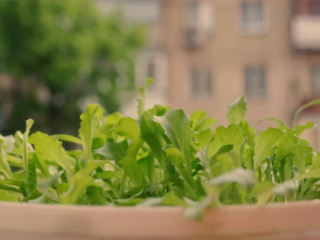In the world of gardening, successful cultivation of a vegetable garden requires careful attention to the nutritional needs of plants.
Fertilizers play a vital role in providing essential nutrients that promote healthy growth and maximize yields. However, with the multitude of fertilizer options available, choosing the best one for your vegetable garden can be daunting.
We will explore the various types of fertilizers, their benefits, and the most effective techniques for application. Armed with this knowledge, you will be better equipped to make informed decisions and optimize your vegetable garden’s productivity.
Types of Fertilizers
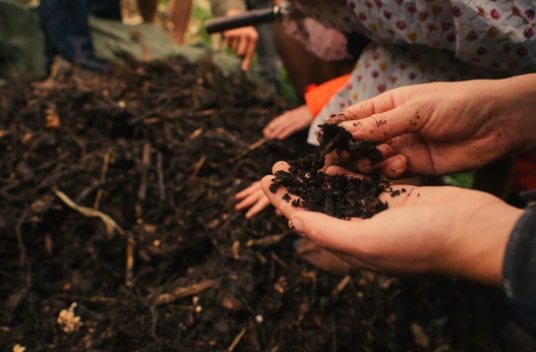
Organic Fertilizers
Organic fertilizers, derived from natural sources, have gained popularity due to their numerous benefits.
They not only supply essential nutrients but also contribute to soil health and microbial activity. Examples of common organic fertilizers include compost, animal manure, bone meal, and fish emulsion.
The nutrient content in organic fertilizers may vary, making it important to understand their composition and nutrient-release rates.
- Benefits of using organic fertilizers a. Enhancing soil structure and water retention b. Providing slow-release nutrients for sustained growth c. Reducing the risk of nutrient imbalances and over-fertilization
- Examples of common organic fertilizers a. Compost: The king of organic matter for enriching soil b. Animal manure: A valuable source of nitrogen and micronutrients c. Bone meal: Boosting phosphorus levels for flowering and root development d. Fish emulsion: A potent source of nitrogen and trace elements
- How to make your own organic compost a. Composting basics: Choosing the right materials b. Composting methods: Hot vs. cold composting c. Tips for maintaining a successful compost pile
Synthetic Fertilizers
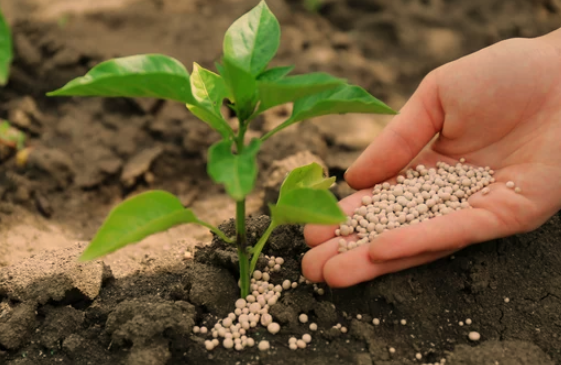
Best Fertilizer for Your Vegetable Garden
Synthetic fertilizers are manufactured using mineral or chemical compounds, providing readily available nutrients for rapid plant uptake.
While they lack the organic matter found in natural alternatives, synthetic fertilizers offer precise control over nutrient ratios. Their popularity stems from their convenience and immediate impact on plant growth.
- Advantages and disadvantages of synthetic fertilizers a. Rapid nutrient availability for quick plant response b. Controlled nutrient formulations for targeted applications c. Potential drawbacks: Environmental concerns and soil health issues
- Popular types of synthetic fertilizers a. Nitrogen-based fertilizers: Urea, ammonium nitrate, ammonium sulfate b. Phosphorus-based fertilizers: Superphosphate, diammonium phosphate c. Potassium-based fertilizers: Potassium chloride, potassium sulfate
- Understanding NPK ratios and their significance a. NPK notation: Unraveling the nutrient ratio code b. Matching NPK ratios to vegetable requirements
Soil Testing and Analysis
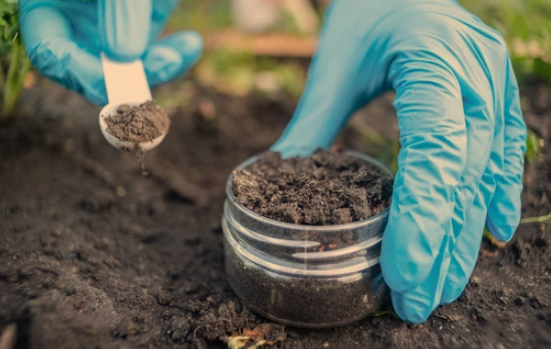
Soil testing and analysis are essential steps in understanding the current nutrient levels and overall health of your vegetable garden’s soil.
Conducting regular soil tests provides valuable information that helps you tailor your fertilization and amendment strategies, ensuring optimal conditions for plant growth and productivity. Here’s a comprehensive guide to soil testing and analysis for your vegetable garden:
Importance of Soil Testing Before Fertilizing
Soil testing is the foundation of a successful fertilization program. It allows you to determine the existing nutrient levels in the soil and identify any deficiencies or excesses that may hinder plant growth. By addressing specific nutrient needs, you can avoid over-fertilization and minimize the risk of nutrient imbalances, which can lead to reduced yields and poor crop health.
How to Conduct a Soil Test at Home or Through a Lab
There are two primary methods for conducting soil tests: home test kits and professional laboratory analysis.
A. Home Test Kits:
- Home test kits are cost-effective and easy to use, making them a popular choice for home gardeners.
- Collect soil samples from various locations in your garden, ensuring you avoid areas with recent fertilizer applications or significant disturbances.
- Follow the kit’s instructions to test pH levels, nitrogen, phosphorus, and potassium content, as well as other essential nutrients.
- Keep in mind that home test kits may have limitations in accuracy compared to laboratory analysis.
B. Professional Laboratory Analysis:
- For more accurate and comprehensive results, consider sending soil samples to a reputable soil testing laboratory.
- Collect multiple soil samples from different areas in your garden, mix them together, and send a subsample to the lab.
- Lab technicians will analyze the samples and provide detailed reports on nutrient levels, pH, organic matter content, and recommendations for specific fertilizers or soil amendments.
Interpreting Soil Test Results
Understanding the soil test results is critical for making informed decisions regarding fertilizer application and soil improvement. Key parameters to look for include:
- pH level: A measure of soil acidity or alkalinity, pH affects nutrient availability to plants. Most vegetables prefer a slightly acidic to neutral pH range (around 6.0 to 7.0).
- Macronutrients: Nitrogen (N), phosphorus (P), and potassium (K) are primary macronutrients needed for plant growth. The soil test will indicate their levels and guide you in selecting fertilizers with appropriate NPK ratios.
- Micronutrients: Essential trace elements like iron, manganese, zinc, and others are necessary for plant health. Soil tests can reveal deficiencies, allowing you to supplement with micronutrient-rich fertilizers if necessary.
- Organic matter: The percentage of organic matter in the soil influences its fertility, water-holding capacity, and overall health. Higher organic matter levels are generally beneficial for plant growth.
Adjusting Nutrient Levels Accordingly
Based on the soil test results, you can calculate the appropriate amounts of fertilizers needed to address any deficiencies. Select fertilizers that provide the required nutrients in the right proportions for your vegetable crops. Avoid applying excess fertilizer, as it can lead to nutrient runoff and environmental pollution.
Timing of Soil Testing
For established gardens, soil testing is best done before the growing season, allowing time for soil amendments to take effect. Aim for early spring or late fall when the garden is not actively planted. Conducting tests every two to three years is generally sufficient, but consider testing more frequently if you encounter specific plant health issues or significant changes in your garden management practices.
Fertilizing Techniques
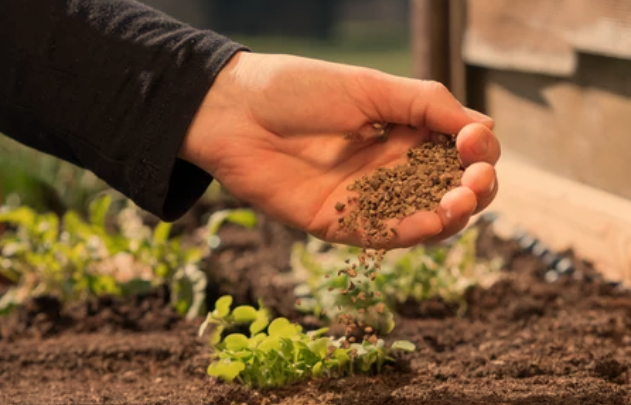
Fertilizing techniques play a pivotal role in ensuring that your vegetable garden receives the right nutrients at the right time. Proper application methods can lead to healthier plants, increased yields, and more sustainable gardening practices. Let’s explore some essential fertilizing techniques to enhance the productivity of your vegetable garden:
Pre-Planting Preparation and Incorporation
Before sowing or transplanting your vegetable crops, it is essential to prepare the soil and incorporate organic matter and fertilizers. This practice sets the stage for robust plant growth from the start. Work compost, well-rotted manure, or other organic fertilizers into the soil to improve its structure and nutrient content. Ensure an even distribution of amendments to benefit all areas of the planting bed.
Side-Dressing During the Growing Season
Side-dressing involves applying additional fertilizer alongside established plants during the growing season. This technique provides a supplemental nutrient boost at critical growth stages, such as when plants are flowering or fruiting. Side-dress with compost, organic fertilizer, or slow-release granules, making sure to keep the fertilizer away from direct contact with plant stems to avoid potential burning.
Foliar Application for Targeted Nutrient Absorption
Foliar feeding is the practice of spraying a liquid fertilizer solution directly onto the leaves of plants. This technique allows nutrients to be absorbed rapidly through the leaf surfaces and quickly delivered to the plant. Foliar application is particularly beneficial when plants show signs of nutrient deficiencies, as it provides an immediate remedy. Use a foliar spray with the correct nutrient composition and spray early in the morning or late in the evening to avoid leaf burn.
Drip Irrigation Fertilization
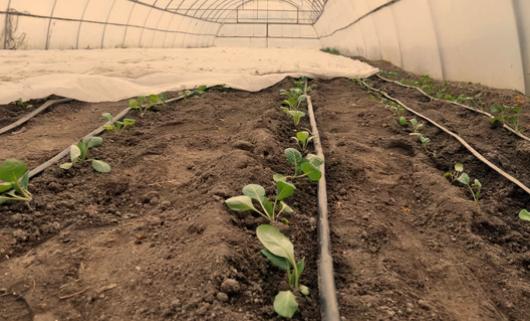
Drip irrigation systems are excellent for applying liquid fertilizers directly to the root zone of plants. These systems are efficient and conserve water while delivering nutrients precisely where they are needed. By combining your drip irrigation system with a fertilizer injector, you can continuously supply a diluted fertilizer solution to your plants during watering sessions.
Incorporating Fertilizers with Planting Holes
For transplants or seedlings, place a small amount of fertilizer in the planting hole before setting the plant. This technique ensures that young plants have access to nutrients as soon as their roots begin to grow into the surrounding soil. Cover the fertilizer with a layer of soil to prevent direct contact with the plant roots.
Banding Fertilizers in Rows
Banding involves creating narrow trenches or furrows along the rows of vegetable plants and applying fertilizer directly into these trenches. This technique concentrates the nutrients around the root zone, promoting efficient nutrient uptake by the plants. After applying the fertilizer, cover the furrow with soil, ensuring the plants’ roots are close enough to the fertilizer source.
Timing and Frequency
The timing and frequency of fertilization depend on various factors, including the type of fertilizer used, the specific nutrient requirements of your vegetable crops, and the soil conditions. Refer to the instructions on the fertilizer package or consult with a local gardening expert to determine the optimal timing and frequency of applications. Be cautious not to over-fertilize, as excess nutrients can lead to imbalances, plant stress, and environmental issues.
Adjusting Fertilization Based on Plant Growth Stages
Different vegetables have varying nutrient requirements throughout their growth stages. For example, leafy greens may need more nitrogen during their early stages, while fruiting vegetables require increased potassium during the flowering and fruiting phases. Adjust your fertilization practices accordingly, tailoring the nutrients to match the specific needs of each plant type.
Balanced Fertilizer Ratios
Ensure that the fertilizer you choose matches the nutrient needs of your vegetable crops. Look for fertilizers labeled with NPK (Nitrogen-Phosphorus-Potassium) ratios that suit the growth stages and requirements of your plants. A balanced NPK ratio ensures that the plants receive the appropriate nutrients to support healthy growth and development.
Mulching for Slow-Release Nutrients
Applying organic mulch to the soil surface around your plants not only conserves moisture and suppresses weeds but also provides a slow-release source of nutrients as the mulch breaks down. Organic mulches, such as straw, leaves, or grass clippings, enrich the soil over time, providing a sustainable source of fertility.
Sustainable Fertilizer Practices
Sustainable fertilizer practices are crucial for maintaining a healthy and productive vegetable garden while minimizing negative environmental impacts. By adopting responsible and eco-friendly methods, gardeners can contribute to a more sustainable future. Here are some sustainable fertilizer practices to implement in your vegetable garden:
Composting: Embrace the Power of Organic Matter
Composting is a cornerstone of sustainable gardening. By recycling kitchen scraps, yard waste, and other organic materials, you can create nutrient-rich compost that improves soil structure, enhances water retention, and fosters beneficial microbial activity. Compost not only provides essential nutrients to plants but also reduces the need for synthetic fertilizers, making it an eco-friendly option for sustainable gardening.
Utilizing Cover Crops and Green Manure
Cover crops, also known as green manure, are crops grown specifically to benefit the soil rather than for harvest. These plants add organic matter to the soil, fix nitrogen, suppress weeds, and prevent soil erosion. Once cover crops have matured, they can be tilled into the soil, adding valuable nutrients and enhancing soil fertility. Integrating cover crops into crop rotation practices helps maintain soil health and nutrient balance, reducing the need for external fertilizers.
Crop Rotation: A Balanced Nutrient Strategy
Crop rotation involves planting different crops in the same area over time, following a planned sequence. Each crop has unique nutrient requirements, and rotating them helps prevent nutrient depletion and reduces the risk of soilborne pests and diseases. This sustainable practice optimizes soil health, enhances biodiversity, and maximizes yields over the long term.
Nitrogen-Fixing Plants: Harnessing Nature’s Fertilizers
Some plants, like legumes (beans, peas, clover), have a symbiotic relationship with nitrogen-fixing bacteria. These bacteria convert atmospheric nitrogen into a plant-available form, enriching the soil with this vital nutrient. Incorporating nitrogen-fixing plants into your garden or using them as cover crops can help reduce the need for external nitrogen fertilizers and promote soil fertility.
Efficient Irrigation: Preventing Nutrient Leaching
Water management is integral to sustainable fertilizer practices. Overwatering can lead to nutrient leaching, where valuable nutrients are washed away from the root zone and into the groundwater. By employing efficient irrigation methods, such as drip irrigation or soaker hoses, you can minimize water usage while ensuring nutrients remain accessible to plants.
Responsible Fertilizer Application: Avoiding Excess
Applying fertilizers responsibly is critical to preventing over-fertilization, which can harm plants and contribute to environmental pollution. Follow recommended application rates based on soil test results and the specific nutrient needs of your vegetables. Applying smaller amounts of fertilizer more frequently can be more effective than a single heavy application, reducing the risk of nutrient runoff.
Eco-Friendly Fertilizer Choices
When selecting fertilizers, opt for products labeled as organic or eco-friendly. These fertilizers are often derived from sustainable sources and manufactured with minimal environmental impact. Additionally, consider using slow-release fertilizers, which provide nutrients over an extended period, reducing the frequency of applications and preventing excess nutrient release.
Vermicomposting: Harnessing the Power of Worms
Vermicomposting, or worm composting, is an eco-friendly way to process kitchen scraps and organic waste. Red worms break down the organic matter, turning it into nutrient-rich vermicompost, which can be added to your vegetable garden to boost soil fertility. Vermicomposting not only reduces organic waste sent to landfills but also provides a sustainable source of natural fertilizer.
Mulching: Conserving Moisture and Nutrients
Mulching vegetable beds with organic materials, such as straw, leaves, or grass clippings, helps retain soil moisture, suppress weeds, and protect against temperature extremes. As the mulch breaks down, it gradually releases nutrients into the soil, contributing to the sustainability and fertility of your garden.
Continuous Learning and Adaptation
Sustainable gardening practices are constantly evolving. Stay informed about the latest research and techniques in sustainable fertilization, soil management, and eco-friendly gardening. Adapt your practices as needed to strike a balance between productivity and environmental stewardship.
Environmental Impact and Safety Considerations
A. The impact of fertilizer runoff on the environment a. Understanding eutrophication and water pollution risks b. Implementing responsible fertilizer application practices
B. Eco-friendly fertilizers and their benefits a. Exploring alternatives like biofertilizers and organic-mineral blends b. Evaluating eco-labels and certifications for environmentally friendly products
C. Safe handling and storage of fertilizers a. Best practices for preventing accidents and exposure risks
Frequently Asked Questions

-
Can I use compost as the sole fertilizer?
Compost is an excellent source of organic matter and provides a wide range of nutrients for plants. In many cases, it can serve as the primary fertilizer for your vegetable garden. However, the nutrient content in compost can vary depending on the materials used and the composting process. It may not always supply sufficient levels of specific nutrients, such as nitrogen, phosphorus, or potassium, in the right proportions for certain vegetable types. Therefore, it is essential to conduct a soil test to assess nutrient levels and supplement with additional fertilizers if necessary. Combining compost with other organic or synthetic fertilizers can help create a balanced and nutritionally-rich soil environment for optimal plant growth.
-
How often should I fertilize my vegetable garden?
The frequency of fertilization depends on several factors, including the type of fertilizer used, the nutrient requirements of your specific vegetable crops, and the soil conditions. In general, a common approach is to apply fertilizers during pre-planting preparation, at the beginning of the growing season, and then supplement with side-dressing or foliar application during the plants’ active growth phase. For most vegetables, a monthly or bi-monthly application during the growing season is adequate. However, it is crucial to avoid over-fertilization, which can lead to nutrient imbalances and environmental issues. Regular soil testing can guide you in determining the optimal timing and frequency of fertilizer application.
-
What’s the best way to apply liquid fertilizers?
Liquid fertilizers are valuable for providing quick nutrients to plants, especially through foliar application. To apply liquid fertilizers effectively, follow these steps:
Dilute the fertilizer according to the manufacturer’s instructions to avoid nutrient burn or damage to the leaves. b. Apply the liquid fertilizer during the cooler parts of the day to minimize evaporation and maximize absorption. c. Use a handheld sprayer or a watering can with a fine spray nozzle to ensure even coverage of the foliage. d. Avoid spraying the fertilizer on flowers or open blossoms, as this may cause damage. e. Combine foliar application with soil application for a comprehensive nutrient supply to your vegetable plants.
-
Can I use synthetic fertilizers in an organic vegetable garden?
The use of synthetic fertilizers in organic gardening is a contentious topic among gardeners. Organic gardening emphasizes natural, sustainable practices and the avoidance of synthetic chemicals. If you wish to maintain strict organic certification or adhere to a completely natural approach, it is best to avoid synthetic fertilizers. Instead, focus on using compost, organic matter, and other natural amendments.
However, some gardeners may adopt a more flexible approach, incorporating minimal amounts of slow-release synthetic fertilizers to supplement organic methods. If you choose this hybrid approach, be mindful of the potential impact on soil health and microbial activity. Always select fertilizers labeled as suitable for organic gardening and use them sparingly, following the principles of responsible and sustainable gardening.
-
What are the advantages of using slow-release fertilizers?
Slow-release fertilizers, whether organic or synthetic, offer several advantages over traditional quick-release fertilizers. These advantages include:
Sustained nutrient supply: Slow-release fertilizers gradually release nutrients over an extended period, ensuring a steady and continuous supply to plants, reducing the risk of nutrient imbalances. b. Reduced leaching: The controlled release of nutrients minimizes nutrient runoff and leaching, decreasing the risk of environmental pollution. c. Less frequent application: Slow-release fertilizers require fewer applications, saving time and effort in the garden. d. Soil health improvement: Slow-release fertilizers support soil structure and microbial activity, fostering long-term soil health and fertility. e. Lower risk of over-fertilization: The controlled release of nutrients helps prevent excessive nutrient buildup in the soil, minimizing the risk of harm to plants and the environment.
Conclusion
In conclusion, achieving a flourishing vegetable garden is dependent on supplying plants with the right nutrients through appropriate fertilization. knowing the diverse range of fertilizers, conducting soil tests, and adopting sustainable practices, gardeners can optimize yields while preserving the environment. Whether you choose organic or synthetic fertilizers, the key lies in striking the right balance to ensure long-term soil health and abundant harvests. So, roll up your sleeves, embark on your vegetable gardening journey, and let the magic of proper fertilization unfold.


